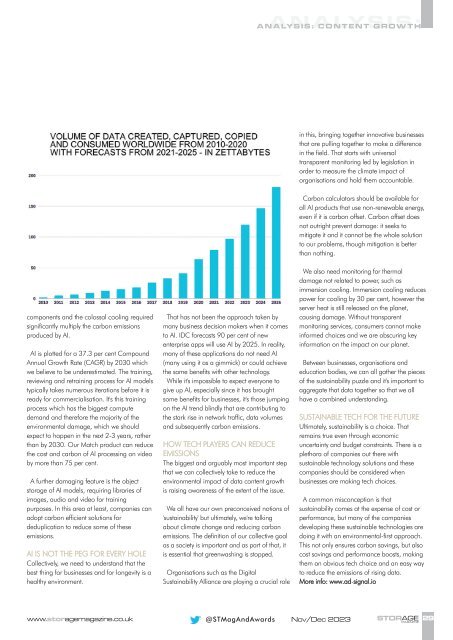ST Nov-Dec 2023
Create successful ePaper yourself
Turn your PDF publications into a flip-book with our unique Google optimized e-Paper software.
Adsignal 28.qxd 01-<strong>Dec</strong>-23 11:05 AM Page 3<br />
ANALYSIS:<br />
ANALYSIS: CONTENT GROWTH<br />
in this, bringing together innovative businesses<br />
that are pulling together to make a difference<br />
in the field. That starts with universal<br />
transparent monitoring led by legislation in<br />
order to measure the climate impact of<br />
organisations and hold them accountable.<br />
Carbon calculators should be available for<br />
all AI products that use non-renewable energy,<br />
even if it is carbon offset. Carbon offset does<br />
not outright prevent damage: it seeks to<br />
mitigate it and it cannot be the whole solution<br />
to our problems, though mitigation is better<br />
than nothing.<br />
components and the colossal cooling required<br />
significantly multiply the carbon emissions<br />
produced by AI.<br />
AI is plotted for a 37.3 per cent Compound<br />
Annual Growth Rate (CAGR) by 2030 which<br />
we believe to be underestimated. The training,<br />
reviewing and retraining process for AI models<br />
typically takes numerous iterations before it is<br />
ready for commercialisation. It's this training<br />
process which has the biggest compute<br />
demand and therefore the majority of the<br />
environmental damage, which we should<br />
expect to happen in the next 2-3 years, rather<br />
than by 2030. Our Match product can reduce<br />
the cost and carbon of AI processing on video<br />
by more than 75 per cent.<br />
A further damaging feature is the object<br />
storage of AI models, requiring libraries of<br />
images, audio and video for training<br />
purposes. In this area at least, companies can<br />
adopt carbon efficient solutions for<br />
deduplication to reduce some of these<br />
emissions.<br />
AI IS NOT THE PEG FOR EVERY HOLE<br />
Collectively, we need to understand that the<br />
best thing for businesses and for longevity is a<br />
healthy environment.<br />
That has not been the approach taken by<br />
many business decision makers when it comes<br />
to AI. IDC forecasts 90 per cent of new<br />
enterprise apps will use AI by 2025. In reality,<br />
many of these applications do not need AI<br />
(many using it as a gimmick) or could achieve<br />
the same benefits with other technology.<br />
While it's impossible to expect everyone to<br />
give up AI, especially since it has brought<br />
some benefits for businesses, it's those jumping<br />
on the AI trend blindly that are contributing to<br />
the stark rise in network traffic, data volumes<br />
and subsequently carbon emissions.<br />
HOW TECH PLAYERS CAN REDUCE<br />
EMISSIONS<br />
The biggest and arguably most important step<br />
that we can collectively take to reduce the<br />
environmental impact of data content growth<br />
is raising awareness of the extent of the issue.<br />
We all have our own preconceived notions of<br />
'sustainability' but ultimately, we're talking<br />
about climate change and reducing carbon<br />
emissions. The definition of our collective goal<br />
as a society is important and as part of that, it<br />
is essential that greenwashing is stopped.<br />
Organisations such as the Digital<br />
Sustainability Alliance are playing a crucial role<br />
We also need monitoring for thermal<br />
damage not related to power, such as<br />
immersion cooling. Immersion cooling reduces<br />
power for cooling by 30 per cent, however the<br />
server heat is still released on the planet,<br />
causing damage. Without transparent<br />
monitoring services, consumers cannot make<br />
informed choices and we are obscuring key<br />
information on the impact on our planet.<br />
Between businesses, organisations and<br />
education bodies, we can all gather the pieces<br />
of the sustainability puzzle and it's important to<br />
aggregate that data together so that we all<br />
have a combined understanding.<br />
SU<strong>ST</strong>AINABLE TECH FOR THE FUTURE<br />
Ultimately, sustainability is a choice. That<br />
remains true even through economic<br />
uncertainty and budget constraints. There is a<br />
plethora of companies out there with<br />
sustainable technology solutions and these<br />
companies should be considered when<br />
businesses are making tech choices.<br />
A common misconception is that<br />
sustainability comes at the expense of cost or<br />
performance, but many of the companies<br />
developing these sustainable technologies are<br />
doing it with an environmental-first approach.<br />
This not only ensures carbon savings, but also<br />
cost savings and performance boosts, making<br />
them an obvious tech choice and an easy way<br />
to reduce the emissions of rising data.<br />
More info: www.ad-signal.io<br />
www.storagemagazine.co.uk<br />
@<strong>ST</strong>MagAndAwards <strong>Nov</strong>/<strong>Dec</strong> <strong>2023</strong><br />
<strong>ST</strong>ORAGE<br />
MAGAZINE<br />
29

















